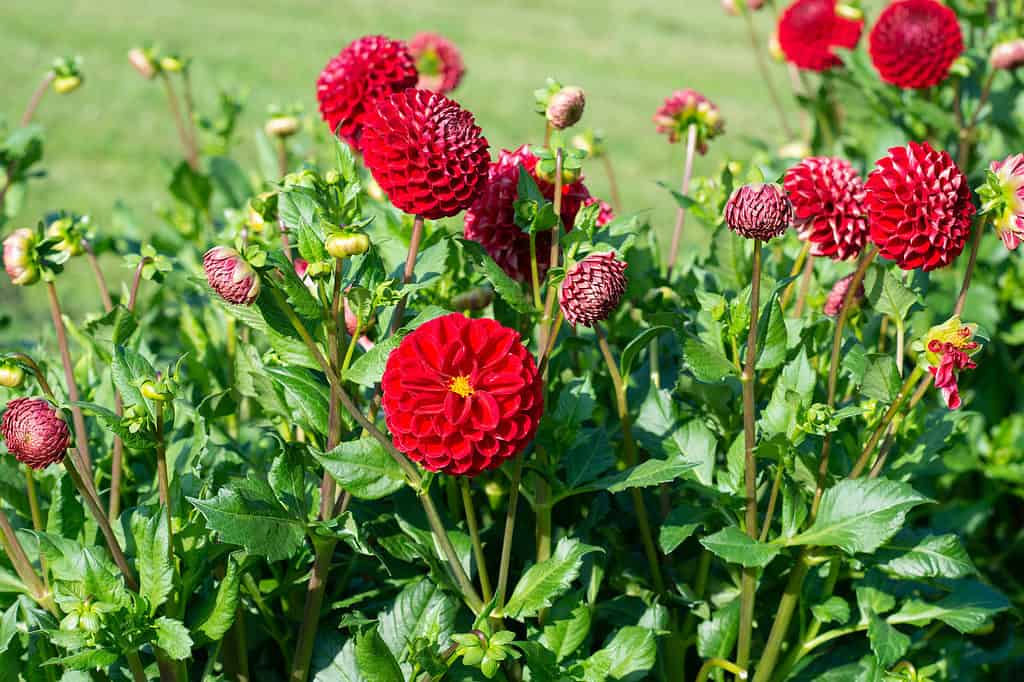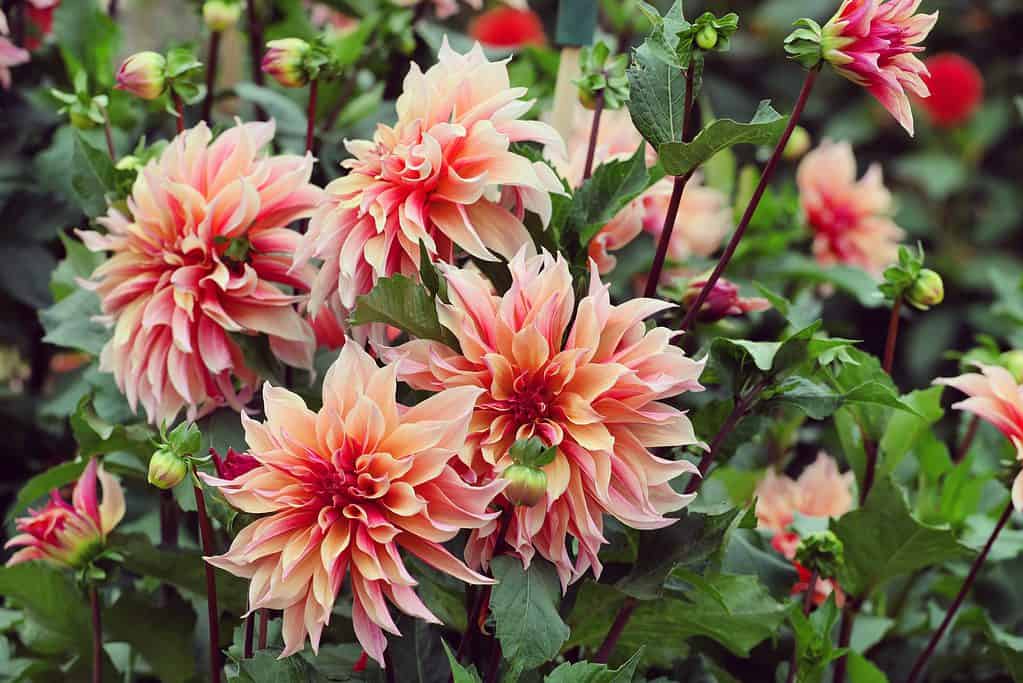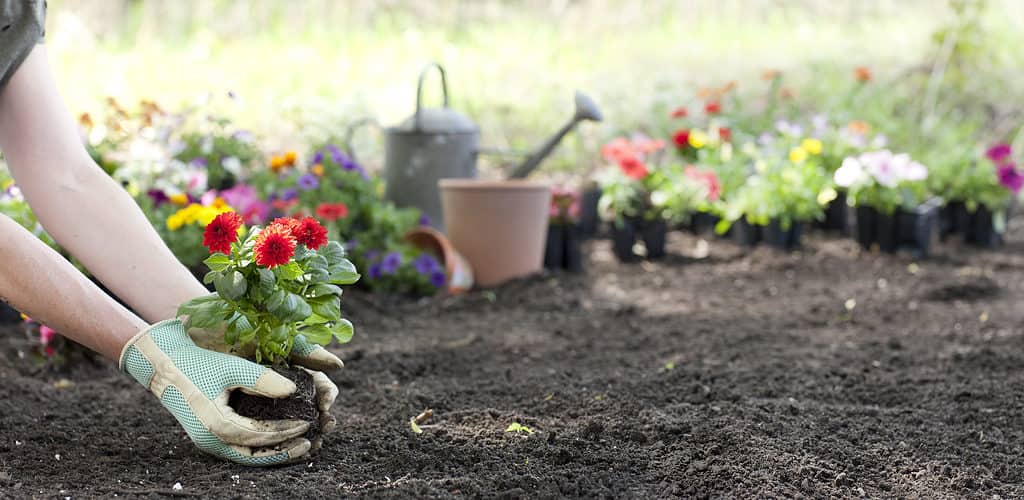Dahlias are perhaps one of the most diverse and widely cultivated families of spring-blooming flowers all across the world and are adored by gardeners and florists alike. They afford the home gardener a wide array of colors and varieties with which to experiment and, with proper care, the opportunity to produce high-quality cut flowers for months on end.
While care and pruning regimens can vary widely from simple to labor-intensive based on the gardener’s goals and their chosen cultivars, the dahlia is sure to be a good fit in any garden.
| Botanical Name | Dahlia sp. |
| Popular Options | Dahlia sp. ‘Cornel’, Dahlia sp. ‘Peaches and Cream’, Dahlia sp. ‘Labyrinth’ |
| Sunlight | Full to partial sun, 6-8 hours per day. Partial shade tolerated. |
| Water | Keep soil moist throughout growing season. Do not allow standing water. |
| Soil | Well-draining, rich in organic material. Mulch to help keep soil temperature temperature cool. |
| Hardiness | Winter hardy perennial in USDA Zones 8-10. Bulbs can be lifted and stored indoors over winter for spring re-planting. Can vary depending on cultivar. |
| Beginner Friendly? | Yes, generally. Care straightforward and simple, but maintenance can be made to be complex depending on the goals of each gardener. |

Dahlias are one of the most diverse and widely cultivated families of spring-blooming flowers all across the world.
©iStock.com/vasare
How Are Dahlias Classified?
The familiar dahlia flower is a member of the aster family, Asteraceae, which includes lettuce, dandelion, sunflowers, and marigolds. These warm-weather plants are native to Mexico and Central America and, when left to their own devices in warm climates, will grow underground as perennials.
While often referred to as a bulb, the dahlia plant actually grows from a tuberous root. This fleshy structure is comprised of modified root tissue and is where the plant stores its nutrients for use during its dormant period and in the case of emergency. Unlike a true tuber, which is made of modified stem tissue and produces growth on all sides of itself, a tuberous root produces above-ground growth only from its crown end. The opposite end, referred to as the distal end, produces the plant’s roots.
There are about 40 known species in the genus Dahlia. Owing to their extreme popularity in the garden, however, there are also hundreds of hybrids and tens of thousands of registered cultivars grown worldwide! Because of their incredible number, cultivars are broken down into the following 10 accepted groups based on their growth characteristics:
- Single
- Anemone
- Collarette
- Waterlily
- Decorative
- Ball
- Pompon
- Cactus
- Semi-cactus
- Miscellaneous
With so many available varieties, it can be difficult to figure out where to start. Below, are five beautiful and easy-to-care-for dahlia cultivars that you can plant alongside your other flower bulbs this spring. We have also outlined some general care advice and growth requirements to help you move in the right direction.
Dahlia Bulbs for Your Garden
Dahlias are some of the longest-blooming plants in the spring garden, beginning to put out flowers in the summer and continuing to do so until the first frost of the year. If you are looking for impressive, long-lasting color in your garden this year, the following three dahlia cultivars deserve a spot in your garden.
Dahlia sp. ‘Labyrinth’
This dahlia cultivar belongs to the decorative group, boasting huge, dinner plate-sized blooms that can measure 8-10 inches across. Each flower is deeply colored and densely packed with peach to pink, ruffled, and feathery petals. Its stems can grow from 3-5 feet in height and should be staked for support due to the size of its blooms.

Labyrinth’ produces dinner plate-sized peach to pink ruffled blooms that can measure 8-10 inches across.
©2052076004/Shutterstock.com
Dahlia sp. ‘Break Out’
Another large-flowered variety, ‘Break Out’ produces white and pink-petaled blooms that show off a golden yellow center. These dahlias make stunning cut flowers, as their color contrast is sure to catch the attention of any passersby. Just like ‘Labyrinth’, this variety produces towering stems of 3-5 feet in height that will likely require staking and benefit from wind sheltering.

“Break Out” produces white and pink-petaled blooms that show off a golden yellow center.
©iStock.com/GGanna
Dahlia sp. ‘Firepot’
Reminiscent of a summer sunrise or a candle burning low, this cultivar lends deep orange and yellow warmth to the garden. This cultivar belongs to the waterlily group of dahlias and is unique from the other two listed cultivars in that it is significantly more compact. In fact, its mature height of only 18-24 inches makes it an ideal variety for container planting!

‘Firepot’ adds beautiful deep orange and yellow colors to your garden.
©Wiert nieuman/Shutterstock.com
How to Care for Dahlia Bulbs
When grown for pristine cut flowers or for entry into exhibition, dahlias are subjected to an exacting pruning and maintenance regimen that can be intimidating to new growers. While this strategy can surely create show-worthy blooms, it is not necessary for those who simply wish to grow dahlias in their own home garden. In fact, with a little attention to detail, dahlias are rewarding to grow and most cultivars are very simple to care for.
Planting
When deciding where to plant your dahlias, choose a site that receives 6-8 hours of sunlight a day. If possible, it is also beneficial to shelter them from wind. Dahlia flower stalks can grow anywhere from 1 and 6 feet in height depending on the cultivar, and they can be susceptible to breakage.
Taller-growing cultivars should also have stakes set into the ground nearby when they are planted. Placing your stakes early prevents your plants from being stepped on or stabbed through later in the season when their roots have set and they are focusing their energy on growth and flower production.
Planting depth and spacing also varies between cultivars, with shorter-growing cultivars preferring a shallower planting depth than taller ones. Most gardeners loosen up a wide patch of soil when planting to ensure that their plants’ roots have an easier time moving through the soil. There are also planting techniques that afford especially tall varieties better support as they grow. Whichever cultivars you choose, remember to place your roots in the ground with their crowns facing up.

When deciding where to plant your dahlias, choose a site that receives 6-8 hours of sunlight a day.
©iStock.com/Liliboas
Sunlight
Dahlia tubers are similar to many other flower bulbs in that they produce their best growth in beds that receive full sun throughout the day. Light shade is tolerated, however, and can even be beneficial in terms of moisture retention during the hotter periods of the summer. Harsh sun and high temperatures can quickly dry out soil and burn tender plant parts, so be sure to choose planting sites appropriate to the cultivars you are planting.
Water
Dahlias are fast growers and prefer their soils to be kept moist throughout their long flowering season. When grown in the garden bed, putting down a layer of mulch can help with moisture retention and insulate soil and roots from high outdoor temperatures. Potted dahlias should be mulched to protect their soil as well, but it is important to note that they will require more frequent watering than those in the garden bed. A good general rule regarding watering is to supply about an inch of water per week. Do not allow your plants’ soil to dry out completely.
Soil Conditions
Soils that are well-draining and rich in organic material such as leaf mould, compost, and well-rotted manure, are ideal for dahlias. That they require drainage is crucial to emphasize as dahlias root tubers are very susceptible to rot and fungal infections in wet conditions.
While they are sensitive to moisture, they tolerate a fairly wide range of pH and will accept anything from slightly acidic soils to slightly alkaline.
End-of-Season Care
Dahlias, being warm-weather plants, must be dug up at the end of the growing season in climates where soils experience hard freezing down to their planted depth. In USDA Zones 8-10, this practice can generally be avoided. However, many gardeners choose to lift their dahlia bulbs anyway to ensure that they are safe throughout the dormant period and to carry out propagation tasks.
Propagation
When planting your dahlias, you probably only deposited a single “bulb” into the ground. It may surprise you then, that each original plant may now consist of many more of these same bulbs. Each one can be carefully separated from the crown of the parent dahlia and stored with the rest of your dormant flowers for planting in the upcoming season.
Storage
Like the rest of your spring flower bulbs, dahlia root tubers should be allowed to dry before storage. Once they have dried for about a day and the surface has begun to wrinkle, brush off any remaining dirt. It is important to do this once the root has dried slightly so as not to damage its outer skin. While you should allow your dahlia roots to dry, it is important that they do not dry out completely.
Once this initial step has been completed, there are multiple options. One of the most common methods is to deposit your roots in a breathable container. Separate them from each other with a soft, bedding material such as peat moss or cedar shavings. At this point, the whole container can be placed in a cool, dark space that is safe from freezing temperatures. Ideally, this space should be kept around 40 degrees Fahrenheit all winter long.
You will need to occasionally check on your dahlias as they rest throughout the winter. Ensure that they are neither molding nor drying out. If your roots seem a little dry, you should lightly mist them to moisten them back up. If any are beginning to rot, this may be a sign that your storage location, your bedding material, or both are too moist. You should assess your storage situation and promptly remove the rotting root tubers. This will prevent the infection from spreading to the other plants.

Dahlia tubers must be dug up at the end of the growing season in colder climates to be stored indoors over winter.
©ABO PHOTOGRAPHY/Shutterstock.com
The photo featured at the top of this post is © iStock.com/bpperry
Sources
- PennState Extension, Available here: https://extension.psu.edu/the-dirt-on-dahlias
- PennState Extension, Available here: https://extension.uga.edu/publications/detail.html?number=C576&title=dahlias
- RHS, Available here: https://www.rhs.org.uk/soil-composts-mulches/leaf-mould
- University of New Hampshire, Available here: https://extension.unh.edu/blog/2019/10/when-should-i-dig-dahlia-tubers-how-should-i-store-them
Thank you for reading! Have some feedback for us? Contact the AZ Animals editorial team.







